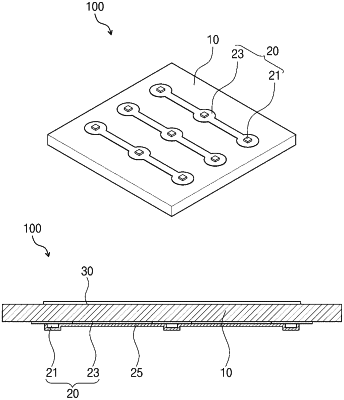| CPC A61L 2/10 (2013.01) [A61F 13/00068 (2013.01); A61F 2013/00174 (2013.01); A61F 2013/0091 (2013.01)] | 20 Claims |

|
1. A dressing for applying to a wound of a patient, the dressing comprising:
a dressing body to make contact with a wound of a patient,
wherein the dressing body has a first surface to make contact with the wound of the patient and a second surface opposite to the first surface; and
a light irradiation device to apply light to the wound of the patient for sterilization and preventing infection and including:
a device board having at least one light emitting diode mounted thereon, the at least one light emitting diode arranged to be on the first surface of the dressing body and in direct contact with the first surface of the dressing body and configured to apply the light toward the wound;
wherein the light has a predetermined range of wavelength bands among an infrared light wavelength, a visible light wavelength, and an ultraviolet light wavelength such that application of the light induces destruction of bacteria present in the wound of the patient or accelerates a recovery of the wound; and
wherein the light irradiation device includes:
first and second light sources operable to emit first light and second light at timings close to each other, regardless of whether the timings overlap or not,
the first light and the second light having mutually different wavelengths, respectively,
wherein the first light has a first wavelength band for inducing the destruction of the bacteria by damaging a cell of the bacteria, as the first light acts on a photosensitizer present in the bacteria, and
the second light has a second wavelength band for inducing the destruction of the bacteria by changing a structure of a genetic material present in the cell of the bacteria.
|